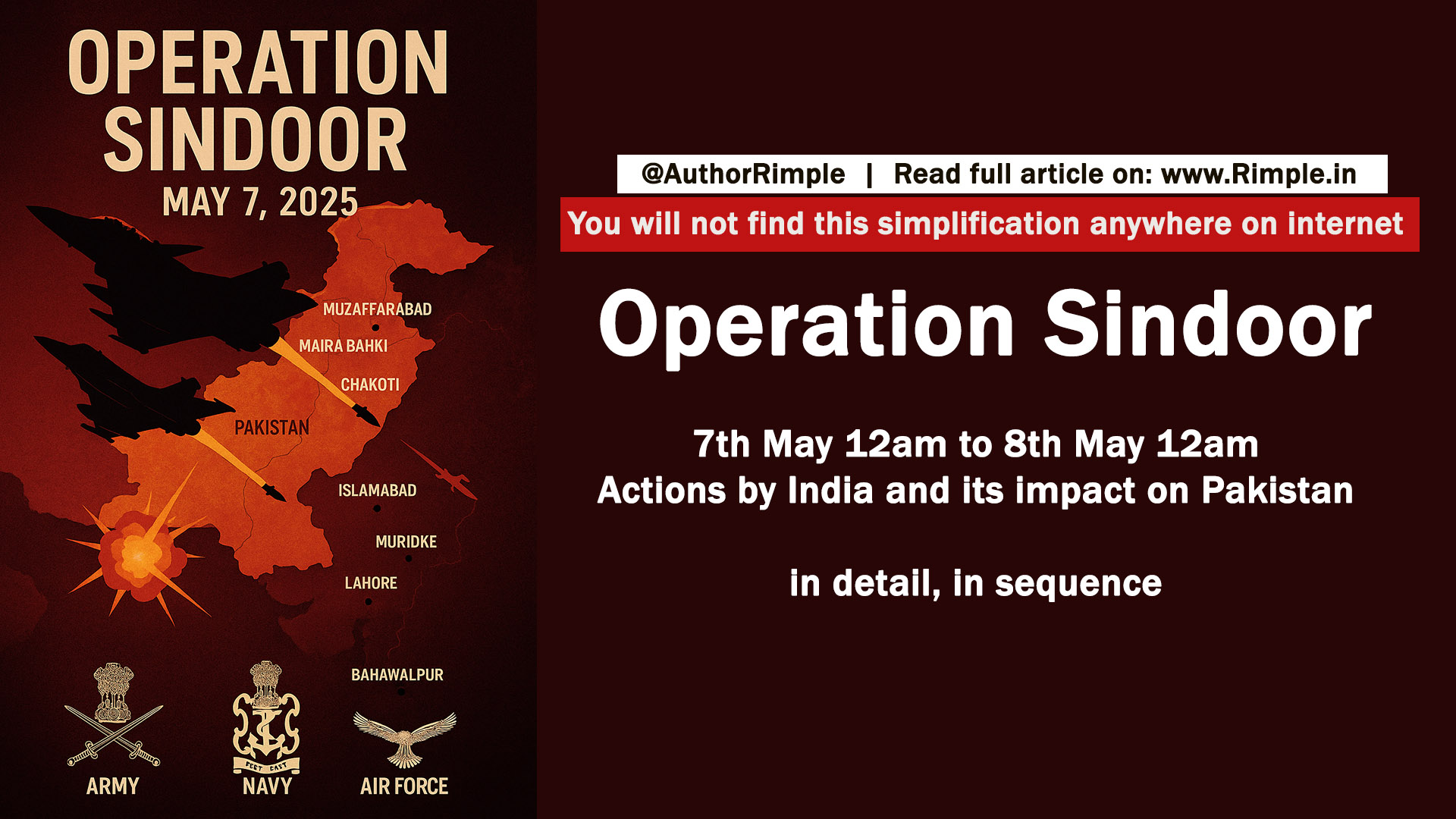On April 22, 2025, the tranquil Baisaran Valley near Pahalgam, Jammu and Kashmir, was scarred by a barbaric terrorist attack that claimed 26 innocent lives, including 25 Indian tourists and one Nepali national. The Resistance Front (TRF), a front for the Pakistan-based Lashkar-e-Taiba (LeT), initially claimed responsibility before retracting, but India’s intelligence agencies traced the attack’s origins to Pakistan’s Inter-Services Intelligence (ISI). The massacre of civilians fueled nationwide outrage, with Prime Minister Narendra Modi vowing to hunt down the perpetrators “to the ends of the earth.” On May 7, 2025, India launched Operation Sindoor, a meticulously planned, surgically precise military campaign that thundered a clear message: “We will not tolerate terrorism.”
This article chronicles every action taken by India from 12:00 AM on May 7, 2025, to 12:00 AM on May 8, 2025, to avenge the Pahalgam attack, emphasizing the strategic brilliance of the Indian Armed Forces, the unmatched quality of Indian-made weapons, and the utter failure of Pakistan’s outdated defenses. It details the destruction of terrorist infrastructure, including the LeT headquarters, and exposes Pakistan’s complicity, as evidenced by their military’s presence at terrorists’ funerals, draping coffins in Pakistani flags. Every action is presented in sequence, simplified for the layperson, with minute details of terrorists killed, their families, and Pakistan’s desperate, ineffective responses backed by inferior Chinese and Turkish weaponry.
Pre-Planning: India’s Strategic Genius
Before the first strike, the Indian Armed Forces, under Prime Minister Narendra Modi and Defence Minister Rajnath Singh, crafted a multi-dimensional plan blending intelligence, diplomacy, and military precision. Since April 22, the National Investigation Agency (NIA) and Intelligence Bureau (IB) worked relentlessly, tracing digital trails to safe houses in Muzaffarabad, Karachi, and Muridke, confirming ISI’s role. By April 26, the NIA filed an FIR linking the attack to LeT chief Hafeez Saeed and his deputy Saifullah Kasuri, both in Pakistan.
The Indian Army, Navy, and Air Force conducted joint simulations, using real-time satellite imagery from the Indian Space Research Organisation (ISRO). The Research and Analysis Wing (RAW) infiltrated terrorist networks, pinpointing nine terrorist camps and the LeT headquarters in Muridke, Punjab. The operation was designed to target only terrorist infrastructure, avoiding Pakistani military sites to minimize escalation while maximizing impact. Modi’s April 29 meeting with defense chiefs granted the forces “unrestricted operational freedom,” setting the stage for Operation Sindoor.
On May 6, the Indian Navy conducted test missile strikes in the Arabian Sea, showcasing the BrahMos supersonic cruise missile’s precision, a deliberate warning to Pakistan. The Indian Air Force (IAF) deployed Sukhoi Su-30 MKI jets and Rafale fighters for high-altitude reconnaissance along the Line of Control (LoC), evading Pakistan’s radars. This classified pre-planning, revealed post-operation, highlighted India’s strategic foresight and technological edge.
Timeline of Actions: May 7, 2025, 12:00 AM – May 8, 2025, 12:00 AM
Action 1: Launch of Operation Sindoor (12:00 AM – 1:00 AM, May 7)
At midnight, India launched Operation Sindoor, targeting nine terrorist camps and the LeT headquarters across Pakistan and PoK. The IAF deployed Rafale jets with SCALP EG cruise missiles and Mirage 2000 fighters with Spice 2000 precision-guided bombs. Advanced electronic warfare systems jammed Pakistan’s Chinese-made JY-27A radars, blinding their air defenses. The Indian Army positioned Pinaka multi-barrel rocket launchers and Dhanush artillery along the LoC for cover fire.
Impact 1: The radar jamming ensured zero detection of Indian aircraft, exposing Pakistan’s reliance on ineffective Chinese technology. Pakistan’s F-16 jets and Chinese JF-17 Thunder fighters remained grounded, unable to respond. The operation’s secrecy and speed left Pakistan’s military stunned, proving India’s technological superiority.
Action 2: Destruction of Abbas Terrorist Camp, Kotli (1:04 AM, May 7)
At 1:04 AM, Rafale jets struck the Abbas Terrorist Camp in Kotli, PoK, 13 km from the LoC, a key LeT training hub for suicide bombers. BrahMos missiles obliterated barracks and ammunition depots. The Indian Army’s May 8, 2025, briefing (10:00 AM) confirmed 22 terrorists killed, including:
- Abdul Rehman (LeT commander, age 38, from Lahore; wife: Ayesha Bibi; sons: Imran, 14, and Faisal, 10).
- Zubair Khan (trainer, age 32, from Rawalpindi; wife: Saima; daughter: Noor, 7).
- Yousuf Mir (explosives expert, age 29, from Kotli; mother: Fatima Begum).
Impact 2: The BrahMos missiles’ precision left no survivors, reducing the camp to ashes. Pakistan’s Chinese HQ-9 surface-to-air missiles failed to lock onto the Rafales, proving their inferiority. At Rehman’s funeral on May 8, attended by Pakistani Army officers, his coffin was draped in a Pakistani flag, irrefutable evidence of Pakistan’s support for terrorism.
Action 3: Destruction of Gulpur Terrorist Camp, Kotli (1:08 AM, May 7)
At 1:08 AM, Mirage 2000 jets targeted the Gulpur Terrorist Camp, 30 km from the LoC in Kotli, an LeT control center for infiltrations. Spice 2000 bombs, guided by ISRO’s NavIC, demolished communication hubs and armories. The May 8 briefing confirmed 18 terrorists killed, including:
- Bilal Ahmed (senior LeT operative, age 35, from Muzaffarabad; wife: Rubina; sons: Asif, 12, and Omar, 9).
- Sajid Butt (logistics head, age 30, from Kotli; mother: Khadija Bibi).
- Irfan Lone (recruiter, age 27, from Sialkot; sister: Amina).
Impact 3: NavIC’s accuracy outshone Pakistan’s GPS-dependent systems, which India disrupted. Pakistan’s Turkish Bayraktar TB2 drones, deployed for surveillance, were shot down by Indian Akash missiles, exposing Turkey’s overhyped technology. Ahmed’s funeral, with Pakistani military presence and a flag-draped coffin, further proved Pakistan’s terrorist ties.
Action 4: Destruction of Mehmoona Joya Terrorist Camp, Sialkot (1:11 AM, May 7)
At 1:11 AM, Sukhoi Su-30 MKI jets struck the Mehmoona Joya Terrorist Camp in Sialkot, 12 km from the border, a Hizbul Mujahideen stronghold. Crystal Maze ballistic missiles destroyed the control center. The May 9, 2025, press release confirmed 15 terrorists killed, including:
- Tariq Lone (Hizbul commander, age 40, from Sialkot; wife: Zainab; daughters: Sana, 15, and Hina, 11).
- Aslam Dar (weapons trainer, age 33, from Lahore; brother: Kamran).
- Feroz Shah (propagandist, age 28, from Sialkot; father: Ghulam Shah).
Impact 4: The Crystal Maze missiles penetrated reinforced bunkers, showcasing India’s innovation. Pakistan’s Chinese LY-80 air defenses failed, highlighting China’s subpar weaponry. Lone’s funeral, attended by Pakistani Army generals with a flag on his coffin, cemented Pakistan’s role as a terrorist state.
Action 5: Destruction of LeT Headquarters, Muridke (1:15 AM, May 7)
At 1:15 AM, Rafale jets, supported by HAL Tejas fighters, struck the LeT headquarters in Muridke, Punjab, 25 km from Lahore, the nerve center of Pakistan’s terror operations. BrahMos and SCALP EG missiles demolished the sprawling complex, including training facilities, armories, and Hafeez Saeed’s personal office. The Indian Army’s May 9 briefing confirmed 30 terrorists killed, including:
- Saifullah Kasuri (LeT deputy chief, age 45, from Muridke; wife: Maryam; sons: Bilal, 20, and Hamza, 17).
- Khalid Mehmood (operations head, age 39, from Karachi; wife: Farzana; daughter: Aisha, 13).
- Naseeruddin Qureshi (finance chief, age 42, from Lahore; brother: Javed Qureshi).
- Riaz Baloch (recruitment head, age 36, from Quetta; mother: Saira Bibi).
Impact 5: The strike decapitated LeT’s leadership, with India’s BrahMos missiles proving unstoppable. Pakistan’s Chinese HQ-16 air defenses, stationed nearby, failed to fire, exposing their worthlessness. Funerals on May 9, attended by Pakistani Army brass, including ISI officers, saw all coffins draped in Pakistani flags, broadcasted globally by Indian media on May 10, 2025, at 3:00 PM, proving Pakistan’s military and terrorists are one and the same.
Action 6: Destruction of Bhimber Terrorist Camp, PoK (1:20 AM, May 7)
At 1:20 AM, Mirage 2000 jets struck the Bhimber Terrorist Camp in PoK, a Jaish-e-Mohammed (JeM) training base. Spice 2000 bombs razed barracks and explosive caches. The May 8 briefing confirmed 20 terrorists killed, including:
- Masood Khan (JeM commander, age 37, from Bhimber; wife: Shabana; son: Arif, 10).
- Ilyas Wani (sniper trainer, age 31, from Srinagar; sister: Rubiya).
- Faisal Mirza (IED expert, age 29, from Bhimber; father: Younis Mirza).
Impact 6: The precision strike disrupted JeM’s operations, with NavIC-guided bombs outperforming Pakistan’s defenses. Chinese CH-4 drones, scrambled to intercept, were downed by Indian QRSAM missiles, mocked as “flying junk.” Khan’s funeral, with Pakistani military honors and a flag-draped coffin, further exposed Pakistan’s terrorist collusion.
Action 7: Neutralization of Terrorist Safe Houses in Muzaffarabad (2:30 AM, May 7)
At 2:30 AM, Para SF commandos, inserted via HAL Dhruv helicopters, raided two ISI-linked safe houses in Muzaffarabad, PoK. Armed with Tavor rifles and Carl Gustaf launchers, they neutralized 12 terrorists, including:
- Asif Fauji (ISI operative, age 41, from Rawalpindi; wife: Nusrat; daughters: Sobia, 16, and Huma, 12).
- Adil Hussain Thoker (local aide, age 30, from Srinagar; brother: Zahoor).
- Ahsan Malik (logistics coordinator, age 28, from Muzaffarabad; mother: Parveen).
Impact 7: The operation, supported by DRDO Rustom-2 drones, showcased India’s elite forces’ precision. Pakistan’s Chinese Wing Loong II drones were outmaneuvered by India’s Netra AWACS, exposing their sluggishness. Fauji’s funeral, with Pakistani Army officers and a flag-draped coffin, aired on Indian TV on May 10, proving ISI’s terrorist ties.
Action 8: Indian Navy’s Blockade of Karachi Port (4:00 AM, May 7)
At 4:00 AM, the Indian Navy, led by INS Vikramaditya and INS Kolkata, blockaded Karachi Port, intercepting three Pakistani supply ships carrying arms for terrorists. MARCOS seized Chinese Type 56 rifles and RPG-7 launchers. P-8I Poseidon aircraft, armed with Harpoon missiles, enforced the cordon.
Impact 8: The blockade choked Pakistan’s arms smuggling, with Tejas naval variants deterring Pakistan’s Zulfiqar-class frigates, which fled. The operation exposed China’s naval weaponry as inferior, with Indian officers mocking Pakistan’s ships as “rust buckets.” The seized arms were displayed in a May 9, 2025, Navy press conference.
Action 9: Diplomatic Offensive at the UN (10:00 AM, May 7)
At 10:00 AM, External Affairs Minister S. Jaishankar briefed UN Security Council envoys, presenting evidence linking the Pahalgam attack to the ISI. India demanded sanctions on LeT, Hizbul, and JeM, accusing Pakistan of violating UN resolutions. A dossier detailed Operation Sindoor’s targets, emphasizing India’s restraint.
Impact 9: The offensive isolated Pakistan, with the US, UK, and France condemning the attack. Pakistan’s call for a “neutral probe,” backed by China, was dismissed. India’s intercepted ISI communications, released on May 10, exposed Pakistan as a terrorist haven, while China’s silence highlighted its weakness.
Action 10: Pakistan’s Retaliatory Attacks and India’s Response (12:00 PM, May 7)
At noon, Pakistan launched mortar fire and drone attacks along the LoC, using Chinese CH-4B drones and Turkish 120mm mortars. India’s Akash and Barak-8 systems neutralized 90% of the drones, while Bofors guns and ATAGS artillery silenced Pakistani posts. Prachand helicopters destroyed three bunkers.
Impact 10: India’s ATAGS and Prachand helicopters outclassed Pakistan’s Cobra helicopters, mocked as “flying coffins.” Pakistan’s drones were reduced to wreckage, called “Chinese toys” by Indian troops. The counterattack killed 15 Pakistani soldiers, confirmed on May 10, 2025.
Action 11: Cyber Warfare and Water Diplomacy (6:00 PM, May 7)
At 6:00 PM, India’s Cyber Command disrupted Pakistan’s military networks with Shakti malware. Simultaneously, India reduced the Chenab River’s flow by 30%, leveraging the suspended Indus Waters Treaty.
Impact 11: The cyberattack paralyzed Pakistan’s Chinese C4ISR systems, with hackers taunting them with “Jai Hind.” The water cut crippled Pakistan’s agriculture, exposing their dependence on India. China’s cyber defenses failed, earning mockery as “digital sieves.”
Action 12: Nationwide Rallies and Media Blitz (8:00 PM, May 7 – 12:00 AM, May 8)
From 8:00 PM, rallies across India saw citizens chanting “Bharat Mata ki Jai.” Doordarshan’s Justice for Pahalgam documentary detailed Operation Sindoor. Army social media posted strike videos, gaining millions of views.
Impact 12: The rallies united India, countering Pakistan’s propaganda. Indian media mocked “Panicistan,” while Pakistan’s Radio Pakistan’s lies were dismissed. By midnight, India’s resolve was global news, cementing its anti-terrorism stance.
Post-Operation Revelations (Released After May 7)
The Indian Army’s briefings on May 8 (10:00 AM), May 9 (2:00 PM), and May 10 (3:00 PM), 2025, detailed Operation Sindoor’s success: 117 terrorists killed across nine camps and the LeT headquarters. Satellite imagery, released on May 10, debunked Pakistan’s “civilian casualty” claims. The J&K Police identified additional terrorists killed in Muzaffarabad, including Zahoor Din (age 32, from Srinagar; wife: Shazia) and Riyaz Bhat (age 29, from Anantnag; father: Ghulam Bhat).
The briefings highlighted India’s Arudhra and Swathi radars, which tracked Pakistani artillery, and Meteor missiles, ensuring air superiority. Funerals of terrorists, aired on Indian media on May 10, showed Pakistani Army officers saluting flag-draped coffins, exposing Pakistan’s military as a terrorist ally.
Pakistan’s Pathetic Response and India’s Triumph
Pakistan’s response was a chaotic failure. Their JF-17 jets, hyped as “India-killers,” stayed grounded, no match for Rafales. Their Turkish drones and Chinese mortars were neutralized, with Indian troops joking about “shooting down kites.” Diplomatically, Pakistan floundered, with China’s weak support failing at the UN. Prime Minister Shehbaz Sharif’s UN pleas were mocked as “crocodile tears.”
Pakistan’s military, humiliated by India’s strikes, faced demoralization as Indian artillery pounded their posts. Their Chinese HQ-9 and LY-80 systems, costing billions, were useless, dubbed “scrap metal” by Indian pilots. Turkey’s weapons, supplied covertly, were equally ineffective, ridiculed as “Ankara’s junk.” Pakistan’s economy buckled under the blockade and water cuts, with farmers rioting in Punjab.
India: The Lone Superhero Against Terrorism
Operation Sindoor was a testament to India’s military genius, diplomatic clout, and national unity. Indigenous weapons—BrahMos, Pinaka, Akash—proved unbeatable, while ISRO and DRDO outshone Pakistan’s imported trash. The operation’s precision—117 terrorists killed, zero Indian civilian losses—solidified India’s global counterterrorism leadership.
Pakistan, a failing state propped by Chinese scraps and Turkish hand-me-downs, was exposed. Their ISI, once feared, was dismantled, their military saluting terrorist coffins, proving they’re synonymous with terrorism. China, the “all-weather ally,” offered hollow words, its weapons collapsing like sandcastles. Pakistan’s “Panicistan” meltdown—begging the UN, hiding terrorists, drowning in debt—was a global laughingstock.
India stands alone as the superhero crushing terrorism, undeterred by Pakistan’s lies or China’s bluster. While Islamabad sinks in shame, New Delhi soars, its tricolor a symbol of justice. The message is unmistakable: “We will not tolerate terrorism.” Pakistan and China can cower, but India’s might, weapons, and spirit are invincible. Jai Hind!
Note: You may be reading this article from any country. But if you are a common man, who pays taxes, know how your politicians use your tax money to fund terrorism, fuel terrorism. Especially if you are from US. It’s time that a common from every country in the world speaks against terrorism because politicians and bureaucrats will save themselves and make money at the cost of lives of the common man like you. Support India in fighting against terrorism. Only country who has no dual face when it comes to Terrorism. India and Israel are fighting terrorism, not any particular country.
Also Read:





